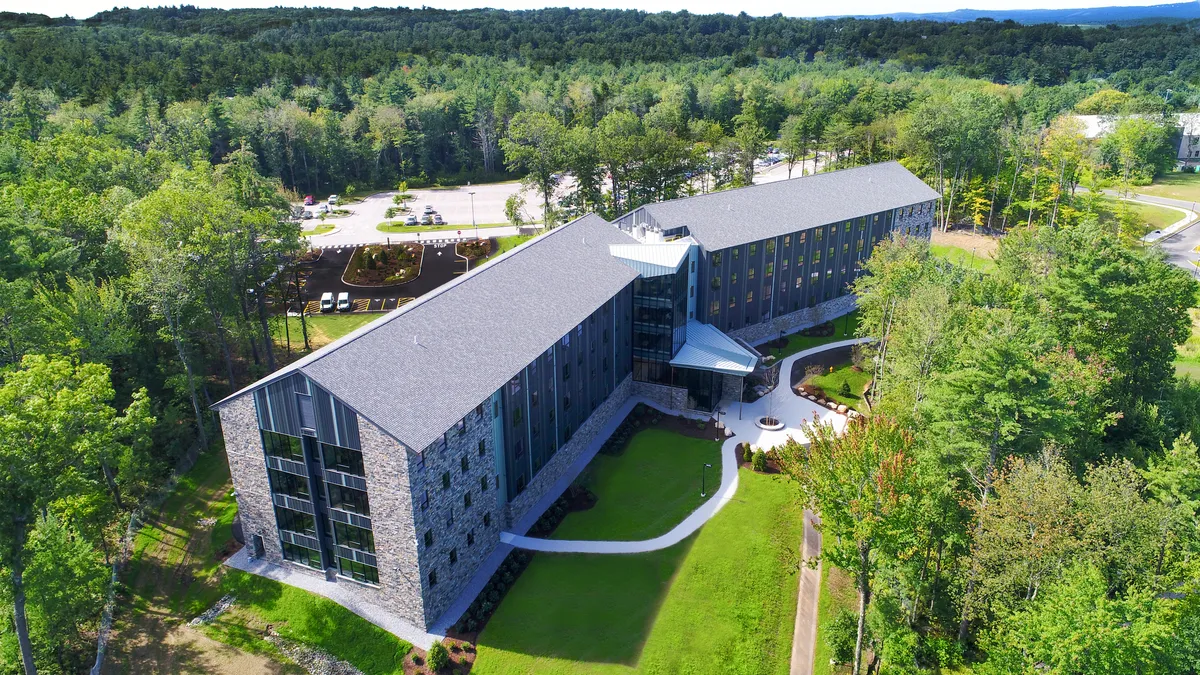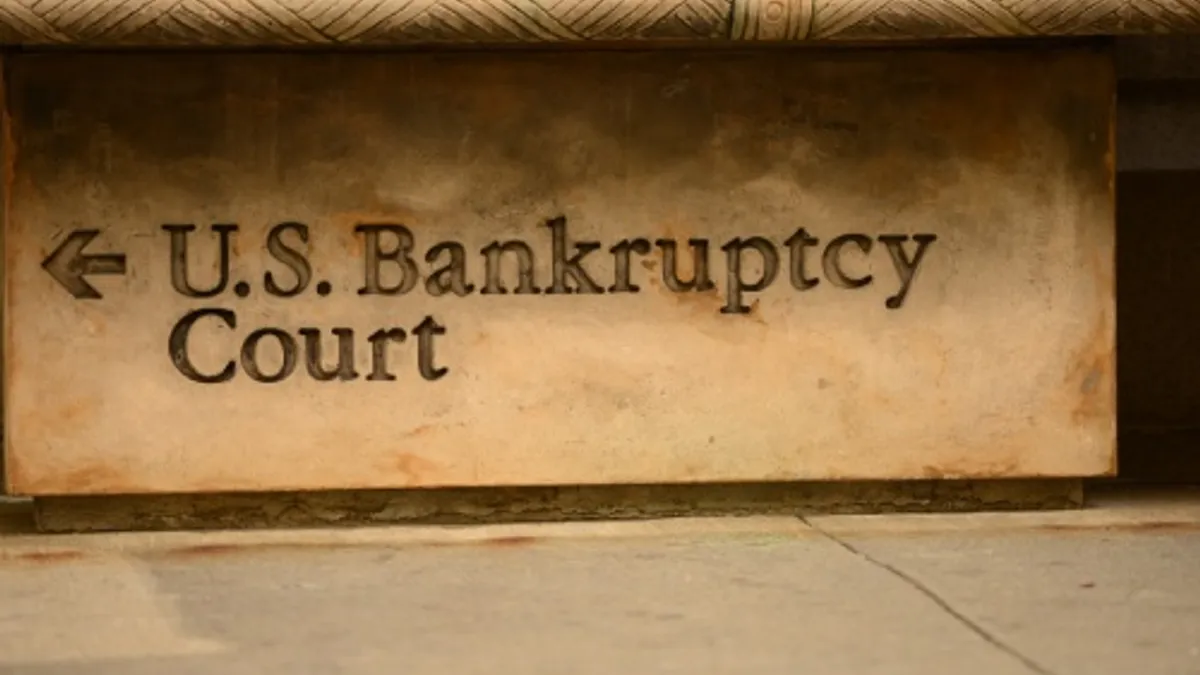Southern New Hampshire University made a splash announcing yesterday it would give incoming freshmen a year of free tuition and have them take online classes while otherwise participating in campus life.
The change, which is for the online giant's residential program, was designed to blunt the pandemic's economic impact for some students. And it comes as many colleges are pressed to weigh similar considerations. But it would also help the university test the waters of a plan to merge in-person and online instruction in a new way.
Paul LeBlanc, the university's president, told Education Dive in an interview that he can't predict just how closely they'll jell the two parts of the university. Southern New Hampshire enrolls more than 130,000 students online, compared to some 3,000 on its campus.
"In an ideal world, what we imagine is that students would be able to pull from our offerings, no matter where they exist, or in what form, and that would all be integrated in one student information system that would be seamless, it would be sort of one-click," he said.
The university hopes to introduce a variety of online, hybrid and/or project-based programs in the fall of 2021. By that point, it also aims to have reduced tuition for campus programs from $31,000 to $10,000 — a 61% cut that makes the cost equivalent to what online students pay.
But there's still work to be done, LeBlanc said. Education Dive talked with him after the announcement about the decision, its timing, the place for a residential experience, and what other changes are underway.
This interview has been edited and condensed for clarity and brevity.
EDUCATION DIVE: These are significant changes. Why are you making them now?
LEBLANC: We've known for a long time that higher ed has been increasingly out of reach for a lot of the people we particularly like to serve. Well before the pandemic and the recession, we had set out on a three-year plan with a target of rolling out new programs we could charge only $10,000 a year for. You could still live on campus, you could have the whole coming-of-age experience. But the tuition would be $10,000 as opposed to our current $31,000. That work was in place. Then the pandemic hit and the world turned upside down.
I remember the 2008-09 recession. I thought that was the darkest year of my 24 years as a president. I think that was a dress rehearsal for what's ahead of us. So I said to our team: seniors in high school don't have the three years to wait for us to roll out new alternatives. We've got to do this soon. We set 2021 as our target. We're not starting at zero and trying to get to 60 miles an hour. We've been playing with these models now for a while with this goal in mind.
For the students coming in this year, this isn't what they planned on. We're going to give them a 100% tuition scholarship, so it takes all the risk away from them. When they see what we roll out for them in 2021, they can make a decision. They'll take all gen eds in the first year, which are the most transferable of courses.
Is this a whole-school pivot, or is this additive and the original experience will still be available?
LEBLANC: It will be available only for returning students because we have a contractual commitment to continue delivering the program they signed up for. So we will teach out those programs, and then the work of the next year is to see: Is there a version of those programs that we can offer at this more affordable rate? Or do we have to come up with very different programs?
We're trying to unbundle these two jobs we get asked to do. New students will have the clubs, organizations, all of that which we associate with residential campuses. But their academic program will look quite different, and there will be aspects of the residential experience that will likely look different as well. For example, we're looking at a whole new term structure. Should we run our campus 12 months a year? We're looking at everything.
Is classroom-based instruction going to be part of the new model?
LEBLANC: I suspect aspects of that will continue. What we hope to do in September of 2021 is to roll out various options so students can choose the one that's best suited for how they learn. Our preference right now is to try to think about different options for students.
You have a massive online program. How much, historically, have the online and campus-based parts of the university been married? And in what way does this new change bring these two pieces together?
LEBLANC: When I arrived 17 years ago they were wholly integrated. I separated them out and really kept them at a distance because we needed to give online the freedom to do things differently. About three years ago, we started to break down those silos. What we're poised to do will certainly take advantage of a lot of what we've built online. That's only possible because of the work we've done the last three years. I can't pretend that we had the prescience to imagine we'd be facing a pandemic and a recession. But I'm sure glad that we did that work, because we have to build upon that collaborative foundation going forward.
How much of this week's announcement is about managing freshmen's expectations, so they show up?
LEBLANC: If the number comes in lower than our typical 1,000 new freshmen, then our conclusion would be, that's okay, this was a tumultuous year, and there's no lost revenue because we already decided they're not going to pay tuition for the first year. And really, the first year is very workable. We have to give them an amazing experience, but we win or lose this bet on fall '21. Are we able to build the kind of programs that allow us to decrease the cost for students down to $10,000 from $31,000?
To what extent did concern over having fewer freshmen commit to attend make your team come up with the announcement for fall 2020?
LEBLANC: Zero. We have made our classes every year. And we know there's a lot going on, but the minute we decided not to charge tuition, that question goes away. Enrollment is about revenue, right? If we make our numbers for the fall, then we make our budget.
Right, but if you get those students in for this year, then you get them in for three more years, presumably.
LEBLANC: People did say, look, we need to have some freshman class because we're going to want to test out what this new model looks like for sophomores. We did have the idea of taking nobody for a year, but we wouldn't have a sophomore class and we have this new model we want to run. That was actually more of the driver, wanting to roll out this model.
So would you have done this even if the pandemic hadn't happened, for the freshmen?
LEBLANC: We would have done new models for sure. The original plan was to roll these out in 2023. The recession, more than the pandemic, is really the issue. The pandemic has immediacy and questions of whether campuses will open, etc. But the thing that's going to be devastating for high schoolers is the recession.
We hear schools saying they don't yet know what's going to happen for fall 2020. And we hear from the student perspective, "If there isn't going to be on-campus instruction and that's what I'm paying for, should I wait to see which colleges are going to open?"
LEBLANC: We've been able to say to our students, we have a 95% student satisfaction rating with our online classes. In the event campus doesn't open, you're covered. If we have to do online delivery, they're going to be fine. And when we can open, you'll come in and we'll do this new model.
Do you know yet when campus will officially reopen?
LEBLANC: We don't. We think it's too early. We'll follow science and good public health policy. You can put me in the camp that's skeptical. I think everyone needs to plan to be open. They darn sure better be planning for what happens if they can't. My assumption is that unless there is widespread, reliable testing and contact tracing, it will be very hard for campuses to open and not put people at risk.
If campus stays closed, Southern New Hampshire will reduce tuition to the current online rate of $10,000 a year for all students. Universities are getting lots of pressure around this right now, and your school has a solid online infrastructure to plug those students into. Why are you lowering the rate?
LEBLANC: Let's imagine campuses can't open for the whole year. To stay on pace, students typically would need to complete 10 courses. For us, if you enroll online, those courses are about $1,000 each. There's your $10,000. I don't know what version of taking undergraduates and keeping them fully online justifies me charging them more than I do the 130,000 students who are paying $1,000 a course. It simply reflects what we charge now.
Do you think this can be a reasonable expectation across higher ed?
LEBLANC: What schools can do, what assets they can leverage, what political pressures they face, the strength of their balance sheet — it's all very different, and it's going to influence how they can proceed. The things we can and can't do are going to be very different from the things another institution can or can't do. It's sort of like advising other people on their relationships. Tread carefully. I know our institution, so I know what we can do. But I don't always know very well what others can do.
How ready is the university to cut tuition across the board, from $31,000 to $10,000?
LEBLANC: We have a lot of work to do. We haven't talked about cuts but we have talked about reallocating or moving functions and being able to cut administrative costs, not by getting rid of people but by leveraging where we have more efficient assets.
An example would be financial aid processing. We process financial aid for 130,000 students online; we do it very well and very fast. We don't think we need to have a separate financial aid processing team for the campus. That's one of the things we'll look at. We may ask students to have different expectations about how administrative work gets done.
Is there anything else we should know?
LEBLANC: The bigger question we'll face now is will the pandemic, and more importantly, the recession be the kind of forcing factor that drives the kind of structural reform and rethinking of higher ed that's been called for for a long time but that's been very hard to achieve? While this announcement got a lot of attention, I know a lot of my colleagues are thinking very hard about how to reinvent their institutions to be meaningful again in a world that looks very different than it did just three months ago.






















